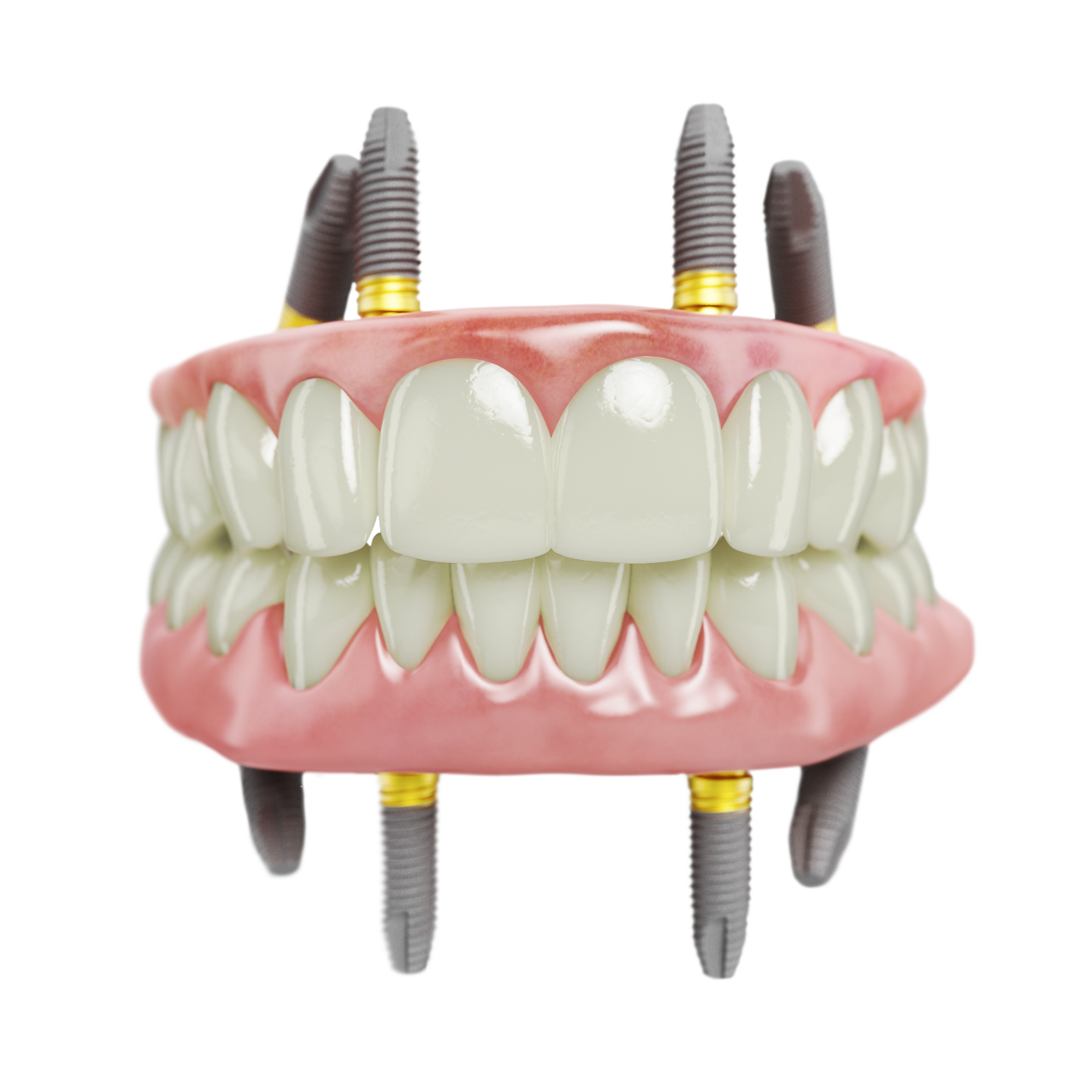Have you ever wondered how dental implants work? How do they become permanent fixtures in your jaw that you don’t have to remove to clean or when you go to sleep? The answer lies in osseointegration, defined as a structural and functional connection between a living bone and the load-carrying surface of an implant. Osseointegration isn’t just for dentistry. It can change the lives of patients who’ve lost limbs and turned to prosthetic solutions. But if you’ve lost a tooth or more than a few and you’re looking for a realistic replacement, implant osseointegration is a significant milestone in treatment options.
Dental implants rely on osseointegration to succeed. A screw, usually made out of titanium, is inserted into the jawbone in the gap of the missing tooth. Over time, bone grows around and fuses to the implant to hold it in place, and an artificial tooth (or crown) is affixed to the top after osseointegration has taken place.
Dental implants tend to have long recovery periods, and patients need healthy jawbones for the procedure to succeed. Sadly, a weakened jawbone is one of the long-term effects of missing teeth, which compromises the bone’s ability to hold implants in place.
The All-on-4® procedure also relies on osseointegration but takes a different approach to dental implants. Like osseointegration, All-on-4® was a significant milestone in the field of restorative dentistry.
Is All-on-4®’s dental implant osseointegration different to how the process occurs for traditional implants? This article takes a look at the science behind All-on-4®, what causes All-on-4® dental implant fusing complications and the significance of osseointegration.
What Is Osseointegration and How It Works
You know All-on-4® dental implants involve osseointegration, but what does that mean, and where does it come from?
Osseointegration is the scientific term for bone ingrowth into an implant. When a metal implant is surgically anchored into the bone, the bone grows around it and fuses with it.
Osseointegration is a complicated process that takes months after the surgery to complete. However, you can divide it into four basic stages:
Hemostasis
Two to three minutes after the implant is inserted, blood coagulates around it and forms collagen fibres across the implant surface. The platelets start to aggregate and the cross-linking collagen fibres form a matrix that sets the foundation for bone repair.
Inflammation
During the inflammation stage, the defence cells begin to clear up the surgical site, removing bacteria and debris.
Proliferative stage
This is when perivascular and osteoblast cells begin to form, allowing new bone development.
Remodelling
Remodelling is when the implant integrates with the bone and tissues for a period of months or weeks after the procedure. This phase needs to be complete before the dentist can place the artificial teeth over the implants, a process known as “loading”.
Dental implants have long treatment and recovery timeframes due to the gradual process of osseointegration, but the results are worth it. All-on-4® dental implants also use osseointegration but draw upon developments in restorative dentistry in order to avoid many of the limitations traditional implants have.
The Evolution of Osseointegration and All-on-4® Innovations

Dental implants have existed in some form throughout human history, but their use in modern dentistry began with the research of Swedish professor Per-Ingvar Brånemark in the early 1950s. Brånemark was studying rabbits to understand the effect of blood flow on bone healing, which involved inserting a special microscope into the leg bones of rabbits. When Brånemark and his team decided it was time to remove these devices, they found that they couldn’t. Titanium was the material the casing was made from.
The medical community were sceptical even as Brånemark developed his own titanium implants for an actual patient in 1965. Yet Brånemark carried on his research until the National Board of Health and Welfare in Sweden approved his dental implants in 1970.
From the early 1970s onward, Swiss dental implant pioneer Professor Andre Schroeder worked independently from Brånemark to establish the scientific basis for dental implants and bring the successful use of osseointegration into mainstream acceptance.
In 1998, Portuguese dentist Dr Paulo Malo came across another breakthrough in implantology while conducting research sponsored by Nobel Biocare. He discovered that four implants, two at the back (angulated for thin or minimal bone) and two at the front in either the upper or lower jawbone, are all that’s required to support an entire bridge of new teeth. The All-on-4® procedure was born.
Now, for more than 25 years, All-on-4® dental implant osseointegration has provided tens of thousands of people with brand-new, realistic-looking smiles. While the procedures have similarities, there are differences between traditional dental implants and All-on-4®. The advantages of the All-on-4® form of dental implant osseointegration include its ability to provide a new smile in as little as 24 hours due to immediate load ability, as well as the way it avoids the need for dental bone grafting by design.
Factors That Impact Osseointegration
All-on-4® has a 98% success rate, but there are certain factors that can increase the risk of All-on-4® dental implant fusing complications, including:
Misaligned implants
An implant needs to be fully surrounded by bone. When the implant isn’t properly encased in bone, it can lead to the metal part of the implant being visible, receding gums and an unnatural-looking crown. Next Smile Australia’s approach uses fewer implants and allows us to strategically angle them towards the strongest areas of the jawbone, minimising this risk.
Poor impressions
If the scans and digital impressions taken by the dentist are not clear and precise, they can provide the blueprints for poorly constructed crowns. Next Smile Australia uses state-of-the-art equipment to ensure our in-house labs get an accurate representation of the treatment you need.
Peri-implantitis
Peri-implantitis, a form of inflammation that affects the gums and tissues surrounding implants, is one of the most common causes of dental implant failure. While peri-implantitis can affect anybody, poor dental hygiene, smoking and conditions like diabetes increase the risk.
Foreign body rejection/allergic reaction
While All-on-4® dental implant osseointegration has a very low failure rate, it’s possible that your body may reject an implant due to an unusual circumstance like a titanium allergy.
Tips for Successful Osseointegration
Here are some tips to avoid All-on-4® dental implant fusing complications:
- Practice proper oral hygiene, including brushing at least twice a day and flossing at least once.
- Avoid smoking and vaping before and after the procedure.
- Avoid hard or crunchy foods immediately after your All-on-4® dental implant osseointegration.
- Avoid grinding or clenching your teeth during the dental implant recovery process.
- See an experienced dental surgeon who takes a professional approach to your dental implant treatment.
Book a Consultation with Next Smile Australia

If you’ve lost all or most of your teeth, it’s likely that All-on-4® is the right kind of treatment for you. Next Smile Australia’s All-on-4® dental implant osseointegration will provide you with a brand new, genuine-looking smile in as little as 24 hours.
Next Smile Australia uses ‘the Malo Protocol’, a two-stage treatment process designed by Dr Malo himself. Dr Malo has personally trained some of Next Smile Australia’s dentists and dental surgeons. Each stage of your treatment process will take place in one of our medically regulated, comfortable Super Clinics and our highly trained and empathetic staff will tailor your treatment plan to your needs.
If you’d like to find out more about the All-on-4® treatment, attend an information session or arrange a personal consultation, get in touch with Next Smile Australia.